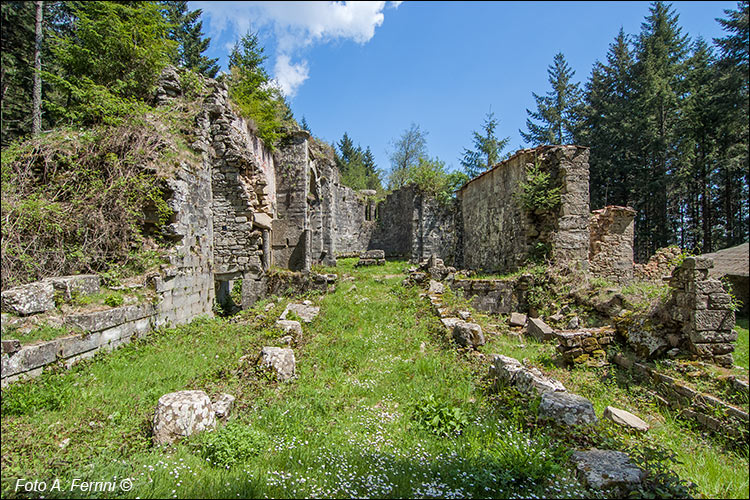Da un castello dei Guidi a un’abbazia benedettina
itinerario sul Pratomagno da Trappola alle Tre Punte, a Santa Trinita e alla Bottigliana
Italiano
ITINERARIO TRAPPOLA – MONTE LORI – BADIA SANTA TRINITA 74
Dal piccolo ponte sul fosso, con una breve salita dentro una fitta abetina, i CAI 32 e 44, sovrapposti, ci hanno condotto davanti ai ruderi di Badia Santa Trinita in Alpe. Anche se l’abbazia è veramente mal messa, l’intera pianta della chiesa è ben distinguibile, quindi ci rendiamo conto quanto era grande. Il primo pensiero che ci viene in mente come possa essere stato costruito attorno al 960 un complesso religioso così grande in un luogo tanto isolato. In realtà, come abbiamo già detto, Santa Trinita fu fondata lungo un’importante direttrice, la Via Abversa, per volere diretto di Ottone I di Sassonia che incaricò di quest’opera due monaci tedeschi, Pietro ed Eriprando. L’abbazia è comunemente definita “la prima del Casentino”. Affermazione sbagliata perché a quel tempo questo territorio non rientrava certamente nel Casentino, affermazione riduttiva perché Santa Trinita fu la prima abbazia di un territorio oggi comprendente il Casentino, la Terra di Arezzo, il Valdarno Superiore. Ed è proprio in quest’ultima terra che l’abbazia ebbe fin dagli inizi dell’XI secolo i suoi maggiori interessi religiosi, economici e politici. Solo attorno al 1360 ha un’espansione verso il Casentino, quando gli Ubertini gli donano il vicino abitato di Carda. Santa Trinità non ha una vita gloriosa molto lunga. Dal 1384 Firenze è divenuta proprietaria di Arezzo e dei territori limitrofi, Vallombrosa, fondata quasi un secolo dopo Santa Trinità nella parte nord del Pratomagno, avanza verso sud con le sue proprietà e influenze politiche religiose. Così, nel 1425, i monaci di Santa Trinità, ormai circoscritti in un piccolo territorio, furono costretti ad assoggettarsi all’abbazia Vallombrosana. From the small bridge over the ditch, with a short climb inside a thick fir tree, the CAI routes 32 and 44, overlapping, led us in front of the ruins of Badia Santa Trinita in Alpe. Even though the abbey is really in bad shape, the entire plan of the church is clearly distinguishable, so we realize how big it was. The first thought that comes to mind is how such a large religious complex could have been built around 960 in such an isolated place. In reality, as we have already said, Santa Trinita was founded along an important route, the Via Abversa, at the direct behest of Otto I of Saxony who commissioned two German monks, Pietro and Eriprando, with this work. The abbey is commonly defined as "the first in the Casentino". Wrong statement because at that time this territory certainly did not fall within the Casentino, reductive statement because Santa Trinita was the first abbey of a territory today including the Casentino, the Terra di Arezzo, the Valdarno Superiore. And it is precisely in this latter land that the abbey had its greatest religious, economic and political interests since the beginning of the 11th century. Only around 1360 did it expand towards the Casentino, when the Ubertini donated the nearby town of Carda to it. Santa Trinita does not have a very long glorious life. Since 1384 Florence has become the owner of Arezzo and the surrounding territories, Vallombrosa, founded almost a century after Santa Trinita in the northern part of Pratomagno, advances southwards with its properties and religious political influences. Thus, in 1425, the monks of Santa Trinita, now limited to a small territory, were forced to submit to the Vallombrosa Abbey.






































































































